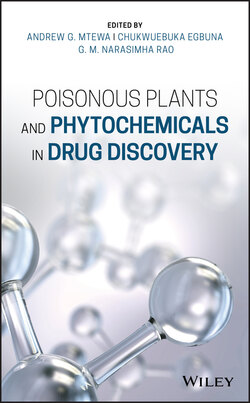Читать книгу Poisonous Plants and Phytochemicals in Drug Discovery - Группа авторов - Страница 25
1.9 Poisonous Plants in Warfare and Bioterrorism
ОглавлениеBioterrorism refers to the use of biological agents to inflict disease and/or death on humans, animals, or plants by a political or religious group or cult to achieve a political or ideological objective [70, 71]. Such agents include some bacteria such as Bacillus anthracis (anthrax), viruses such as variola virus (smallpox), rickettsiae, fungi, or biological toxins such as ricin. For the agent to be used successfully, it must first be “weaponized,” or produced in sufficient quantities in relatively stable and easily disseminated forms [70]. Therefore, human populations, crops, and livestock are considered possible bioterrorist targets [70]. Concerns over the use of biological as well as chemical weapons have increased recently. In fact, bioterrorist incidents have increased markedly since 1985 [71], with attempted uses of ricin by various groups, especially in the USA [72]. According to Balali‐Mood et al. [73] there was a 10‐fold increase in the number of published articles following the terrorist attacks in the USA on 11 September 2001.
Ricin is a toxalbumin derived from the seeds of the poisonous plant Ricinus communis (castor bean; family Euphorbiaceae). Ricin acts by inhibiting protein synthesis and is one of the most toxic biological agents known. Ricin is classified as a category B bioterrorism agent and a schedule 1 chemical warfare agent according to the US Centers for Disease Control and Prevention [74]. It can be extracted from castor beans and purified. It is stable under ambient conditions and is readily accessible and relatively easy to extract. The fact that ricin has been used previously in high‐profile assassination cases – such as that of Georgi Markov, a leading communist dissident exiled in London, in 1978 [75, 76] and similar assassination attempts with ricin elsewhere [71] – has contributed to its publicity. On a larger scale, Iraq developed a weapons of mass destruction program between 1985 and 1991, in which approximately 10 L of concentrated ricin solution was produced for field testing [77]. Schep et al. [78] have, however, argued that although ricin is deadly it is not suitable as an agent of bioterrorism for a large population since a substantial mass of powder needs to be extracted, formulated, and produced in the right particle size to target the relevant parts of the lung to be fatal. Additionally, the facilities for the large‐scale manufacture of ricin are not available to terrorists. Ricin has also been used for suicide [8].
In 1975, the Biological and Toxin Weapons Convention was ratified by several countries. In spite of the agreement, bioweapon threats from groups such as terrorist organizations and rogue states continue to worry public health authorities [71].
R. communis is widely used for medicinal purposes in traditional medicine [45], despite the highly toxic nature of ricin. Tyagi et al. [79] conducted an extensive review of the recent advances in ricin research and its potential therapeutic applications, especially as an anticancer agent.
